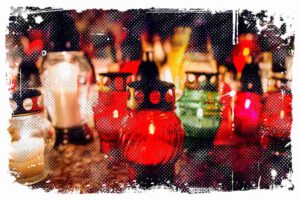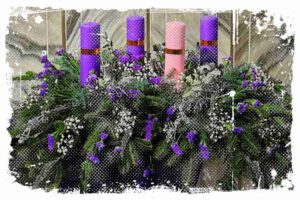The Catholic holiday of Candlemas, also known in Poland as the Presentation of the Lord, is celebrated on the 40th day after Christmas which is February 2. It marks the end of the season of carol singing in churches, and parishes and believers alike take down their Christmas trees. Have you ever wondered where the name of the holiday comes from, what its origins are, and what a thimble is? Learn more in this article.

In 2024, it will be a Friday. Even though it’s not a holiday, it’s an important day for Catholics. On that day, we’ll take the large wax candles you’ve had since your baptism, called thimbles, to liturgical services. We may also make a petition to the Virgin Mary, who is considered the mediator between God and you.
You may also like my other article about customs and traditions during autumn season in Poland: From Cabbage Pickling to Folk Dancing: 6 Unique Polish Autumn Traditions
History of Candlemas Day
It has long been a part of our traditions. You may be surprised to learn that customs similar to the Catholic holiday were present in our tradition before the Church existed. On February 2, the ancient Slavs celebrated a holiday called „Gromnice,” which marked the change of seasons from winter to spring.
„Gromnica” in Poland is a kind of candle. This day was associated with the natural cycle of life and nature. People lit bonfires and prayed to the god Perun, the guardian of fertility and weather, asking for protection and a good harvest.

The Feast of the Presentation of the Lord and the Purification of the Blessed Virgin Mary are related to the law in effect at the time of Jesus’ birth. This law required Mary to bring her firstborn son to the temple 40 days after birth and offer the required sacrifices – a lamb or a pair of doves – to symbolically redeem the child.
It was during this event in the Temple in Jerusalem that the old man Simeon likened Jesus to light. This custom of „oczyszczenie” (purification) was practiced in Poland until the interwar period of the 20th century and was called „wywód”.
Candlemas Customs in Poland
The holiday celebrated on February 2 includes the symbolism of light, and in churches candles called „gromnica” are blessed. According to ethnographer Zygmunt Gloger, these candles were lit during thunderstorms and storms to protect against danger, and were hung on the wall above the bed of devout Catholics to remind them to be ready for death at any moment. „Gromnica” were also given to the dying as a sign of readiness for death. In processions, it was considered a bad omen to hold a „gromnica” in one’s hand.
Before going to church to bless a candle, it was customary to decorate it with a green branch (e.g. boxwood or juniper) and a ribbon. In some regions, such as Rzeszów, the candle was tied with a piece of linen, which was believed to bring fertility. During the service, the gromnica was closely watched: if the wax dripped profusely, a long and frosty winter was expected. On the way home from church, if the flame was accidentally extinguished, it meant that someone in the family would soon die; three drops of wax on the hand were a sign of prosperity.
After returning home, it was popular to sprinkle the entire household with gromnica and to light a fire in the stove with its flame. In many places, it was customary to make a cross on the ceiling or door frame with the smoke of the gromnica and to bless one’s possessions with it.
Candlemas Traditions and Practices in Different Periods

Gromnica were often kept in homes with the blessed Easter palm. They were lit in front of the image of the Mother of God on every Marian feast day. It was believed that the light of the candle not only dispelled the darkness, but also protected against floods, hail and lightning. In Kociewie, during a storm, the family would gather around the table with a lighted candle and the father would read a fragment of the Gospel. The smoke of the candle was believed to protect against diseases of the throat and ears, as well as toothache.
February 2 traditionally marks the end of winter. People have long believed that lighting a gromnica, or candle, would keep wolves away. Winter was a dangerous time for people and their livestock, so a gromnica was taken on every trip into the forest. Legend has it that the Mother of God saved a young wolf from angry villagers and made him her protector.
Popular Superstitions and Beliefs Related to Candlemas Day
According to another story, she walks through the fields at night with a lighted candle, protecting the winter crops from the cold and illuminating the way for stragglers. She is accompanied by a wolf called „Gromnik”. Sayings about Gromnica, the candle, tell us that a bright day during Gromnica foretells greater frosts and blizzards, a wet Gromnica foretells a long winter, and a frosty Gromnica foretells a bountiful harvest.
You should know that in Pałuki and Kociewie people were afraid of the sun’s rays on February 2, because it was believed that they could be dangerous for animals, especially sheep, causing them to die or get scabs. To prevent this, the windows of cowsheds and pigsties were closed. In addition, the proverb „On the day of Candlemas – stay healthy, my dear” was used to remind bachelors who wanted to get married during Carnival that they had to propose on that day or else they would have to wait until Easter.
The Candlemas Mother of God is typically depicted holding a candle and either wolves or a basket of larks. Notable works of art dedicated to this theme include those of Piotr Stachiewicz and Teodor Axentowicz.
References
- https://buzz.gazeta.pl/buzz/7,156947,29424925,co-oznacza-swieto-matki-boskiej-gromnicznej-i-kiedy-je-obchodzimy.html
- https://www.rmf24.pl/news-dzis-matki-boskiej-gromnicznej-skad-nazwa-i-co-to-za-swieto,nId,5807903#crp_state=1



